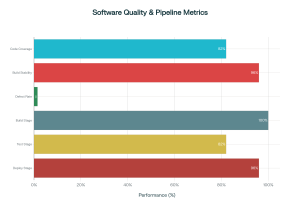Software testing is a critical phase in the software development lifecycle (SDLC), ensuring the quality, reliability, and stability of applications before they are delivered to users. Among the various types of testing methodologies, Sanity Testing and Smoke Testing are two essential types of regression testing used to verify the basic functionality and stability of software builds.
Although the terms are sometimes used interchangeably, they serve distinct purposes at different stages of the testing process. This blog will help you understand the key differences between sanity testing and smoke testing, their applications, and when each should be used. We’ll also go through real-world examples and sample code scenarios to show how these testing methods are implemented.
What Is Sanity Testing?
Sanity testing is a narrow and deep approach to testing where the goal is to verify that a particular bug fix or a new functionality works as expected, and nothing else has broken due to the recent changes. It’s not an exhaustive test but rather a focused test to ensure a specific function of the application is still working after minor changes or bug fixes.
Sanity testing is typically performed after receiving a software build that has undergone minor changes in code or functionality. It helps testers determine whether it is reasonable to proceed with further, more exhaustive testing.
Benefits of Sanity Testing
- Saves time by focusing on specific functionality rather than retesting the entire application.
- Detects issues early before they affect other parts of the system.
- Reduces the time and cost associated with regression testing.
- Ensures that bug fixes or enhancements did not break existing functionality.
When Should Sanity Testing Be Used?
- After receiving a software build with minor changes.
- When a particular module or function has been updated or fixed.
- To verify the correctness of newly implemented features.
Example of Sanity Testing
Let’s say a login feature was broken in a web app. A developer fixes the issue. A sanity test will focus solely on whether the login now works and doesn’t affect unrelated features.
Here’s a simple Node.js example with Express:
javascript
// login.js
app.post('/login', (req, res) => {
const { username, password } = req.body;
if (username === "t500_prod_admin" && password === "12345") {
return res.status(200).send("Login successful");
} else {
return res.status(401).send("Invalid credentials");
}
});
A sanity test would check:
javascript
const request = require('supertest');
const app = require('./login');
test('Sanity Test - Valid Login', async () => {
const response = await request(app).post('/login').send({
username: 't500_prod_admin',
password: '12345'
});
expect(response.status).toBe(200);
expect(response.text).toBe("Login successful");
});
What Is Smoke Testing?
Smoke testing, also known as “build verification testing,” is a shallow and wide approach that checks the basic functionality of an application. It verifies whether the critical features of the software are working and if the build is stable enough for further testing.
Smoke tests are usually automated and performed on every new build. It’s like turning on a device to see if it powers on before testing deeper functions.
Benefits of Smoke Testing
- Quick feedback on the health of a build.
- Identifies major issues early in the development cycle.
- Reduces wastage of resources on unstable builds.
- Helps maintain confidence in continuous integration pipelines.
When Should Smoke Testing Be Used?
- After receiving a new software build.
- Before running extensive regression or functional tests.
- During continuous integration and deployment (CI/CD) cycles.
Example of Smoke Testing
Imagine you’re building an e-commerce app. A smoke test would check if:
- Homepage loads.
- Users can log in.
- Product search works.
- Cart is accessible.
Here’s a basic smoke test scenario in Python using Selenium:
python
from selenium import webdriver
driver = webdriver.Chrome()
driver.get("http://localhost:3000")
assert "Welcome" in driver.title # Homepage test
driver.find_element_by_id("login-button").click()
assert driver.current_url.endswith("/login") # Login page access
driver.quit()
This verifies that the main application is functional at a high level before deeper testing begins.
Key Differences Between Sanity and Smoke Testing
While both sanity and smoke testing help determine whether software is ready for further testing, they are distinct in terms of scope, timing, and purpose.
- Scope:
1. Smoke testing covers broad and shallow functionality.
2. Sanity testing is narrow and deep, focusing on specific features or bug fixes. - Timing:
1. Smoke testing is done on initial builds.
2. Sanity testing is done on interim builds with minor changes or fixes. - Objective:
1. Smoke testing aims to check overall stability.
2. Sanity testing aims to check the rationality of specific functions. - Automation:
1. Smoke tests are often automated and integrated into CI/CD pipelines.
2. Sanity tests are usually manual, though they can be automated for repeated changes. - Example Use Case:
1. Smoke Test: “Does the homepage load after deployment?”
2. Sanity Test: “After fixing the login bug, can users log in successfully?”
Why Both Are Important
Smoke and sanity tests are essential for maintaining the quality and stability of software projects.
Without smoke testing, developers may begin testing deeper features on a broken build, wasting time. Without sanity testing, small code changes can introduce bugs that go unnoticed until later in development.
Integrating both into your workflow allows for:
- Faster feedback loops.
- Reduced bug leakage.
- Better resource allocation for QA teams.
Conclusion
Sanity and smoke testing are vital tools in a developer or QA engineer’s toolkit. While both may seem similar at first glance, their differences in scope, timing, and purpose make them suitable for different scenarios.
Smoke testing acts as a gatekeeper to determine whether a build is testable. It verifies the critical features and ensures the application doesn’t crash on launch.
Sanity testing, on the other hand, validates the logic of specific features after a change or bug fix, confirming that things work as expected without performing exhaustive checks.
In modern software development, especially in agile and DevOps environments, these tests play a crucial role in ensuring software quality, accelerating delivery, and maintaining user satisfaction. Leveraging automation tools and integrating them into your CI/CD pipelines can streamline these processes and prevent costly failures down the line.
By understanding and applying both testing strategies effectively, teams can minimize risks and build robust, user-friendly applications.



